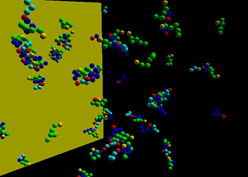New VCell 7.7 is released: any kinetic laws can be simulated stochastically;
simulation results can be sent to ImageJ for analysis; Single Sign On browser-based login.
Check lectures and tutorials from the 26th ONLINE Annual Workshop on Computational Cell Biology at our YouTube channel https://www.youtube.com/@compcellbiol8898.
VCell
VCell (Virtual Cell) is a comprehensive platform for modeling cell biological systems that is built on a central database and disseminated as a web application.
- One-stop simulation shopping: deterministic (compartmental ODE or reaction-diffusion-advection PDE with support for 2D kinematics), stochastic reactions (SSA solvers), spatial stochastic (reaction-diffusion with Smoldyn), hybrid deterministic/stochastic and network-free agent based simulations. Support for membrane flux, lateral membrane diffusion and electrophysiology.
- Explicit network or graphically expressed rules can be used to model
- Free with automatic installers for Windows, Mac OS and Linux.
- Biology-based interface for inexperienced modelers; enter reactions and pathways and VCell automatically creates the math for you. Experienced modelers can enter math directly.
- Our remote servers can run complex simulations from any low-cost laptop
- Geometries from 2D or 3D microscope images or from idealized analytical expressions.
- Access models and simulations from anywhere using the VCell database; models can be shared among collaborators or made publicly available.
SpringSaLaD
 SpringSaLaD is a stand-alone software tool to explicitly model binding events and state changes among multivalent molecules. It is one of the first algorithms to account for crowding effects within multimolecular clusters. Spring SaLaD models proteins as sets of reactive sites (spheres) connected by stiff springs. The impenetrable spheres capture excluded volume and steric hindrance effects. Langevin dynamics are used to model diffusion of each reaction site, and binding reactions are governed by probability based on diffusion coefficients of the sites, the site radii and the macroscopic on rate. Go here to download the software or read more about the about Spring SaLaD.
SpringSaLaD is a stand-alone software tool to explicitly model binding events and state changes among multivalent molecules. It is one of the first algorithms to account for crowding effects within multimolecular clusters. Spring SaLaD models proteins as sets of reactive sites (spheres) connected by stiff springs. The impenetrable spheres capture excluded volume and steric hindrance effects. Langevin dynamics are used to model diffusion of each reaction site, and binding reactions are governed by probability based on diffusion coefficients of the sites, the site radii and the macroscopic on rate. Go here to download the software or read more about the about Spring SaLaD.
Computational Cell Biology
CompCellBio.org is designed to provide a central site for access to software, model repositories, quantitative repositories and educational resources for computational cell biology research. Developed under the NIGMS National and Regional Resources funding that maintains COPASI and Virtual Cell (VCell), two of the most powerful modeling environments for computational cell biology, the website provides the broader community with information and resources to aid in the development of computational models of cell biology.
Who Are We?
The Virtual Cell was developed with funding from the National Institute of General Medical Sciences (NIGMS) as a Biomedical Technology Research Resource at the Center for Cell Analysis and Modeling (CCAM), and is currently funded by R24 GM137787. CCAM continues to develop new technologies for mathematical models of cell and systems biology through development of new physical formulations of biological mechanisms, developing the numerical methods for mathematically simulating these mechanisms, and bulding software infrastructure to deliver these tools for different types of modeling applications including large reaction network applications, spatial applications and detailed molecular interactions. Meet the VCell Team.
Where Are We?
VCell is developed at The Center for Cell Analysis & Modeling, at UConn Health. Established in 1994, CCAM consists of faculty trained in diverse backgrounds from chemistry, physics, and experimental cell biology to software engineering. Research at CCAM focuses on the development of new approaches for in vivo measurements and manipulation of molecular events within the cell, as well as new computational approaches to organize such data into quantitative models. CCAM is home to the Microscopy Facility, housing numerous extensive fluorescent imaging microscopes, and the High Performance Computing facility.

Please acknowledge the VCell Resource in all publications. VCell is supported by NIH Grant Number R24 GM137787 from the National Institute for General Medical Sciences. And please reference the appropriate citations.
Employment
Please see the CCAM Employment page for opportunities.
News
For additional posts see News & Events.
A rule-based VCell model used in J Immunol publication
2025-03-09. Alberto Millan from Kite Corp and Lewis Lanier from UCSF published a study on ITAM-mediated human Natural killer cells signaling. VCell was used to create a rule-based model in .bngl (BioNetGen) format.
Millan, A. J., Allain, V., Nayak, I., Libang, J. […]
The 26th Annual CompCellBio workshop
2025-02-28. The 26th Computational Cell Biology workshop took place ONLINE for the 5 days, February 24-28th. Cell biologists and biophysicists leaned how to use VCell (https://vcell.org/) and SpringSalad (https://vcell.org/ssalad) software to develop spatial and […]
VCell at CellBio 2024
2024-12-18. VCell was represented at the American Society of Cell Biology Annual Meeting 2024 in San Diego. Michael Blinov and Margaret Johnson (John Hopkins University) led the session on Biophysical Modeling of the Cell on December 14th. On December 15th, […]
A VCell spatial model of Myosin II and cortexillin I assembly was published by Iglesias team
2024-11-08. The team of researchers from John Hopkins University used spatial modeling with VCell to analyze the role of Myosin II and cortexillin I assembly within the mechanoresponsive mechanism grounded in experimentally measured parameters.
Dolgitzer, D., Plaza-Rodríguez, A. I., Iglesias, M. […]
Computational Cell Biology workshop
2024-07-22-24. VCell and COPASI teams run 25th Annual Workshop on Computational Cell Biology. Nine students (one could not attend due to flights being cancelled) from Arkansas, Connecticut, New York, Ohio, Texas and Viginia worked with instructors for 3 days, developing […]
VCell Partners
-VCell acknowledges our collaborative partners that enhance VCell capabilities
-Software Associates
VCell uses Install4J, a multi-platform installer builder to create our executables.














